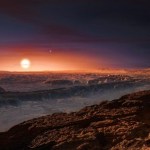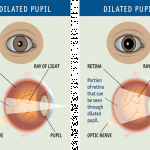exoplanet
The star that is nearest our own has a planet that could be habitable by Earthlings.
This is very important news.
The news comes to us from this research paper in Nature: A terrestrial planet candidate in a temperate orbit around Proxima Centauri by Guillem Anglada-Escudé, Pedro J. Amado, John Barnes, Zaira M. Berdiñas, R. Paul Butler, Gavin A. L. Coleman, Ignacio de la Cueva, Stefan Dreizler, Michael Endl, Benjamin Giesers, Sandra V. Jeffers, James S. Jenkins, Hugh R. A. Jones, Marcin Kiraga, Martin Kürster, Marίa J. López-González, Christopher J. Marvin, Nicolás Morales, Julien Morin,…
“Next to reasoning, the greatest handicap to the optimum development of Man lies in the fact that this planet is just barely habitable. Its minimum temperatures are too low, and its maximum temperatures too high. Its day is not long enough, and its night is too long... These factors encourage depression, fear, war, and lack of vitality. They describe a planet, which is by no means perfectly devised for the nurturing or for the perpetuation of a higher intelligence.” -James Thurber
It's been just about three years, now, since the first announced discovery of a planet in another star system…
"You can spend too much time wondering which of identical twins is the more alike." -Robert Brault
You've of course heard by now the news that Kepler, the most successful and prolific planet-finding mission of all time, has probably reached the end of its useful lifespan.
Image credit: NASA / Kepler Mission / Wendy Stenzel.
With nearly 3,000 planet candidates under its belt, including many approximately Earth-sized (and some even smaller), and many within their parent star's habitable zone, we now know that, at least planet-wise, we're not alone in our galaxy.
Image credit: NASA Ames /…
Have you complained about the weather recently? On the gas giants at the edges of our solar system, Uranus and Neptune, hurricane-like storm systems as big around as Earth blow 1000 km/h winds for years on end.
Voyager II image of Neptune, showing storm features. Image: NASA
But wait…What exactly constitutes weather on a giant gas planet? Here on planet Earth, there is a clearly delineated gas layer enveloping the solid/liquid layer we call home. Our weather arises from our planet’s rotation and the solar heating of its surfaces. On a rapidly-rotating gas planet (a day on Neptune is 16…
"It suddenly struck me that that tiny pea, pretty and blue, was the Earth. I put up my thumb and shut one eye, and my thumb blotted out the planet Earth. I didn't feel like a giant. I felt very, very small." -Neil Armstrong
Here on our little wet rock in our Solar System, we often remind ourselves what a small world Earth actually is. The farther out in space we reach, the more this appears to be true.
Image credit: NASA / Apollo 11, taken by Command module pilot Michael Collins.
The Earth is the largest of the four inner, rocky planets in our Solar System, at more than 12,000 km in…
This is like an episode of Dr. Who. A star erupted and vaporized the atmosphere of a nearby planet. Holy crap. Details:
JUNE 28, 2012: An international team of astronomers using data from the NASA's Hubble Space Telescope has made an unparalleled observation, detecting significant changes in the atmosphere of a planet located beyond the solar system. The scientists conclude that the atmospheric variations occurred in response to a powerful eruption on the planet's host star, an event observed by NASA's Swift satellite. This artist's rendering illustrates the evaporation of exoplanet HD…
"Some prophecies are self-fulfilling
But I've had to work for all of mine
Better times will come to me, God willing
Cause I can't leave this world behind" -Josh Ritter
You sure can't leave this world behind. At least, not very easily. The reason for it, of course, is gravity.
Image Credit: Physclips, via the University of New South Wales' School of Physics.
Here on the surface of the Earth, the gravitational potential well is pretty large; large enough that there's no easy way off. Sure, you can pour a huge amount of energy into a rocket to try and overcome this gravitational potential…
"I went into a clothing store, and the lady asked me what size I was. I said, 'Actual'. I'm not to scale." -Demitri Martin
When you look out at the Universe, what you can see is limited, at the most fundamental level, by the size of what you look with. This is why you can see dimmer objects at night -- when your pupils are dilated -- than you can when your pupils are constricted.
Image credit: National Institute of Health.
This same principle that applies to your eyes applies to telescopes as well. As telescopes have grown in size, so has our ability to see deeper into the Universe, as…
First, I should say right away that the planet that has been in the news so much lately is not known to be "earth like" ... depending on what you think "earth like" is. What we know is that the planet orbits its star in a position that allows for the possibility that water on its surface could be liquid. But, the possibility that the planet has a "surface" ... as opposed to some increasingly dense gaseous layer like Neptune ... has not yet been established. Not that this would favor life one way or another. For all we know, getting life started on a hard crust covered earth is way harder…
Canadian-French Hawaii Telescope transit observations show super-earth is probably a mini-neptune
Ray Jay reports from Torino that his group has CFHT observations on GJ 1214b transits, suggesting it has a H/He atmosphere, and is therefore probably not a "super-earth", but more likely an ice giant with neptune like atmosphere.
This is interesting, suggesting indirectly the planet migrated from beyond the ice line and did some gas accretion onto its core before reaching the inner system.
Looking forward to seeing the paper.
Swiss astronomers recently discovered the small exoplanet, Gliese 581 e, calculated to have a minium mass less than twice that of our own dear planet. This planet resides within the same solar system as Gliese 581 d, which scientists speculate could be capable of supporting life. "With a minimum age of these planets of 7 billion years, you can bet that if life did form there, it's probably awfully interesting by now," ventured ScienceBlogger Ethan Siegel from Starts With a Bang.
Related ScienceBlogs Posts:
Say Hello to my Little Rocky Friend!
Two Earth Mass Planet
"It's Life, Jim, But Not…







